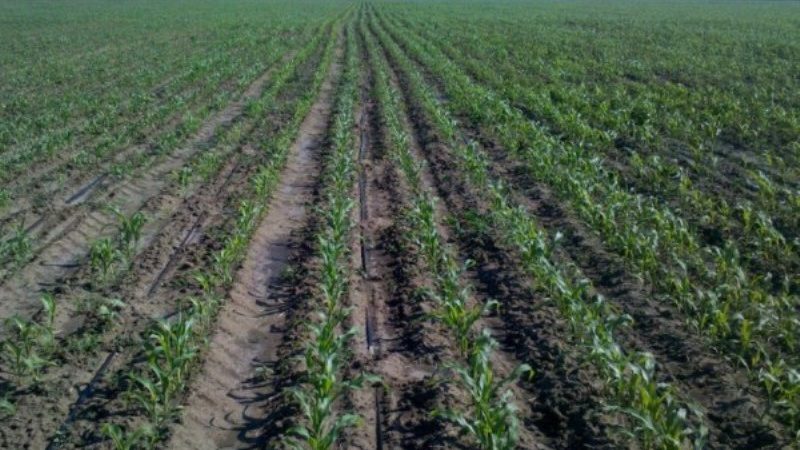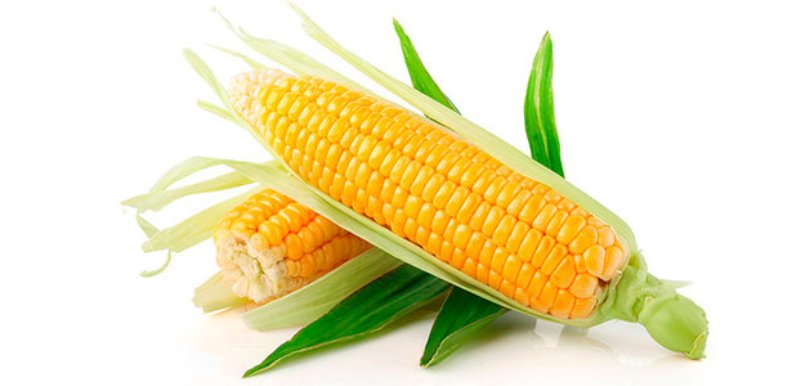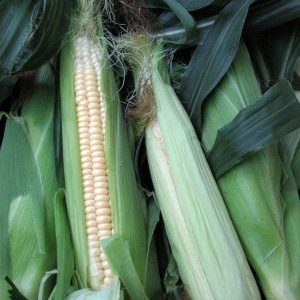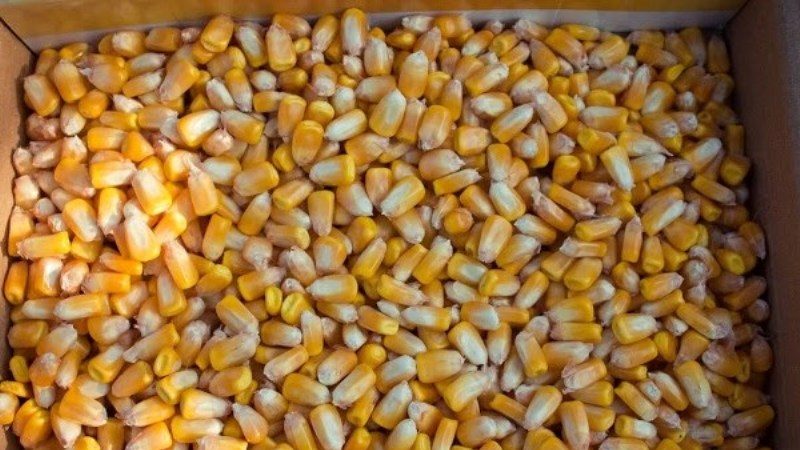How to soak corn for planting and grow rich crops from ready-made seeds
The history of corn as an agricultural crop is about 9 thousand years old. It has been actively used and is now being used in cooking and medicine. It ranks second after wheat in terms of sales in the world among cereals.
Corn is suitable for dietary nutrition - when consumed in moderation, it helps to lose weight by stimulating the cleansing of the digestive tract of toxins. Thanks to its high amount of antioxidants, the grain protects the skin from aging. Eating maize lowers the risk of diabetes and cardiovascular disease. Planting a crop is simple, but it is worth considering the nuances of choosing a variety and preparing seeds. In the article, we will tell you how to choose a variety and soak corn for planting, how to care for seedlings, how to harvest and preserve the crop.
The content of the article
Variety selection and seed selection

There are a great many varieties of corn. The choice depends on the geographic location, weather conditions and the purpose of the application.
The best varieties and hybrids for obtaining a rich harvest on a personal plot: sweet grade Lakomka 121, Dobrynya, Spirit, Early gold, Ice nectar, Sundance, Pioneer, Syngenta, Jubili.
In central Russia, where summer is short, early corn is recommended: Early sweet, Trophy F1, Jubilee F1, Landmark F1, Ladozhsky 250 MV, Ladozhsky 191, Madonna. These varieties and hybrids give a good harvest already 2.5 months after planting.
Mid-season includes: Sweetstar F, Maksaliya, Brusnitsa, Favorite, Pearl, Delicatessen, Mermaid, Spirit F1.
Late ripening varieties - the most resistant to diseases: Polaris, Bashkirovets, Russian bursting.
If you need corn for popcorn, choose special varieties: Lopai-lopai, Ping-pong, Volcano, Red Zeya, Gostinets, Vnuchkina joy, Air. Please note that they are especially demanding to care for. They are suitable for popcorn because there is a drop of juice inside each grain, which breaks the shell when heated.
The best feed varieties: Pearls, Adevei, Saratov medium-sized sugar, Aurika, Golden Fleece, Kuban, Viola.
For growing on the balcony take undersized varieties, for example, Skvirka, Delikatesnaya, Kulikovsky.
Seeds for sowing are selected in the fall. Choose large, evenly ripe ears. Moreover, the plants from which the cobs are collected must also be high, not touched. pests and diseases... Selected fruits are dried in the sun and stored in a dry, well-ventilated room until spring, calibrated to size.
Important! Only one variety is grown on the site so that there is no cross-pollination and parental properties are not lost.
Seed preparation
The main rules for preparing seeds:
- Before planting, they are calibrated in size, choosing only large, saturated and bright colors.
- A week before sowing, the cobs of maize are left for 3-4 days for heating in the sun - this helps to accelerate germination. For this, the fruits are placed in a gauze bag.
- To prevent diseases, grains are treated with fungicides.
- Some summer residents practice seed hardening. They put the grains in a damp cloth bag and put them in the refrigerator for five days.
- Then they are soaked in a solution of potassium permanganate for 20 minutes for disinfection, washed, placed in a container and placed in a warm place. When small roots appear, the seeds are planted in the ground.Some summer residents do not wait for the grains to hatch and, after soaking the seeds for a couple of hours, immediately after that they plant them in the ground.

Planting seeds for seedlings
If the region is characterized by a short, rainy summer, which does not allow harvesting the cobs on time, seedlings will help. The seedling method brings the harvest closer to the whole month.
When to sow? In central Russia, cereals are sown for seedlings in late April - early May, counting about a month before planting in open ground. The further north the plot of land is, the later they begin to grow seedlings. Seedlings of maize are planted in open ground around the beginning of June.
The soil is shed, the seeds are buried to a depth of 2-3 cm. The soil is moistened regularly as it dries. For the full development of plants, illumination with fluorescent lamps is used. With the beginning of growth, seedlings feed mineral complexes.
Important! Overgrown seedlings will not yield a good harvest.
The seedling method is good in that, with the right approach, up to two crops per season are harvested from one site.
One more rule: seeds cannot be germinated in a common box. Better to sow them into peat tablets in special containers, divided into small sections. Allowed to be planted in ordinary disposable plastic cups or cut plastic bottles.
Planting seeds in open ground
Maize loves sunny and open places. It is also important to know the correct timing of planting seeds. With a lack of heat, the sprouts will not be able to increase the required volume of green mass and form cobs.
Corn grows densely, but without interfering with each other. Correct calculation: 5-7 seeds per 1 sq. m.
Timing
Cereal planting time: when the soil temperature warms up to + 10 ° С. For the southern and central ones, this is the end of April - the beginning of May.
If, according to the weather forecast, the region is getting warmer, corn can be planted in open ground earlier, after warming up the soil under the film.
Attention! In cold weather, the seed does not germinate for a long time, moisture is accumulated in the ground and often sprouts, having already fallen ill with fungal infections.
Soil preparation
The landing site is determined from the sunny side, well-ventilated. Ideal if wheat, legumes, cucumbers or tomatoes were grown there last season.
The land is prepared for planting in the fall. They dig in a garden bed, fertilize with manure and phosphorus-potassium fertilizers. Corn does not like acidic soils, so such soil is deoxidized with dolomite flour or lime.
In the spring, two weeks before planting, they dig again, removing all the weeds.
In the spring, they re-dig it to a shallower depth, remove weeds, and apply complex fertilizers. The work is carried out two weeks before planting the seeds.
Landing nuances
Plant corn seeds in rows. The distance between the rows is 50-70 cm, between the seeds is about 15-20 cm.
Advice! On the package with seeds, the nuances of planting a variety are always described. Follow these guidelines.
The depth of planting grain in heavy, loamy soils is 4-5 cm, in ordinary soil - 5-6 cm, in light and loose - 8 cm.
Important! Single bunches of corn are not planted. It is not capable of self-pollination, it is a cross-pollinated plant.
Growing and care
Although corn is called the queen of the fields, it is unpretentious to care for and does not require much effort from the gardener. However, proper care will increase yields and make the ears more sugar-free. In addition, maize needs protection from disease just like other plants in the garden.
Thinning seedlings

With good germination, if the plantings are thick, it is worth thinning them out, leaving tall and green plants at a distance of 15-25 cm from each other.
When pulling out an extra sprout, proceed carefully and hold the soil so as not to damage neighboring plants.
Hilling and removing weeds
Corn loves loose soil, so the soil is loosened regularly and weeds are removed every two weeks. Plants are spud once or twice a season so that the heavy bush does not fall.
Watering and feeding
Water the maize regularly, providing moisture to the soil to a depth of 15 cm. The crop loves moisture and needs watering during the entire growing period.
It is not worth pouring: the roots should be in moist, not wet soil. If the leaves have acquired a gray-purple hue, watering is stopped.
Grain is fed using organic matter and mineral fertilizers and following the timing:
- for the first time - with manure, chicken droppings after the appearance of 3-4 sheets;
- again - with ammonium nitrate, potassium-phosphorus fertilizer in liquid form in 2-3 weeks.
Protection against disease and disease
Excess moisture leads to the rapid spread of fungal diseases. The most common problems:
- Helminthosporiosis. The leaves dry out and die off, forming spots in the shape of an ellipse or rectangle of orange-brown color. A dark bloom appears in the ears between the grains. Diseased plants are removed, the rest are treated with biological or chemical fungicides.
- Fusarium - ear disease. Several foci with fluffy white, pink or purple mycelium appear among the grains.
- Rust. Yellow, rust-like spots appear on the leaves. The disease develops quickly, the ears do not have time to form.
- Dusty smut... Together, the fetus remains a sloppy lump of uncertain configuration. Infected from soil. The pathogen remains in the ground for up to nine years.
- Bubble smut. The entire stem of the plant is covered with swollen bubbles. First, they are slimy, then dry out and multiply by pollen.
- Stem rot. Another type of disease when the whole bush is affected. The leaves dry out, the roots rot and easily come out of the soil. As a result, the bushes fall to the ground.
Control methods
It helps to avoid diseases:
- the right choice of varieties and hybrids that are resistant to fungal diseases;
- deep digging of the earth;
- soil preparation in autumn, treatment with fungicides;
- dressing of grains with antifungal drugs;
- adherence to sowing dates, regular weeding and thinning;
- correct watering, constant loosening, weed removal;
- preventive spraying of plantings with fungicides.
Harvesting
Corn is harvested during full maturation kernels in the upper ears of the main stalks when wrapped turn white, the hairs on top of the ear turn brown, and the grains harden and acquire a sheen and light yellow color.
Maize is kept frozen or dried. Fresh plucked in the refrigerator cobs are kept up to two weeks. Freeze grains or whole ears by pre-scalding. They do not lose their properties within six months.
If the fruit is harvested for seed, wait until the hairs on top of the ear are completely dry and brown. This means that excess moisture is gone from them. Such grains will be an excellent seed material.
Tips from experienced summer residents
Pre-sowing processing of grains helps to increase immunity and rid seeds of pathogens. If you plan to plant your own material, pay attention to the following tips:
- Even at the stage of grain selection, large, full-bodied grains are selected without flaws in the form of black spots, stripes, etc. Most diseases are seed-borne and only 10% are soil-borne.
- Be sure to carry out disinfection, for example, in a 1% solution of potassium permanganate. The liquid does not penetrate and does not spoil the seed, but kills infections on the surface. Corn grains are soaked in the solution for 45 minutes. To obtain a 1% mixture, dilute 1 tsp in three glasses of water. potassium permanganate without top.
- Soak the seeds in clean water. To do this, fill a 1.5 liter bottle with water and wait for it to freeze in the freezer by half, leave the ice, pour out the rest. Soak the seeds in water made from melted ice. Such water has the ability to quickly penetrate into the seed, accelerating germination.Some people add Epin, potassium humate, Zircon or aloe juice. But it is advised to refrain from adding ash or fertilizers.
- Corn grows in clusters, so the kernels are not planted singly.
- You should not plant different varieties next to each other: they will be pollinated and lose varietal characteristics.
- If the maize seeds are irregular and shriveled, they are most likely sweet corn. They germinate worse and need more abundant watering.
- Popcorn varieties are planted on the sunny side, even partial shading will prevent the cobs from ripening over the summer.
- To determine whether the cobs are ready to be harvested, press on a ripe grain: if milk juice appears, harvest, if a clear liquid, wait.
Conclusion
The unpretentiousness of corn makes it possible to cultivate this plant in almost all regions. With minimal care, maize yields a high yield and delights with nutritious ears.
And having mastered the simple secrets of agricultural technology, you will provide yourself with delicious juicy corn until the next summer season.